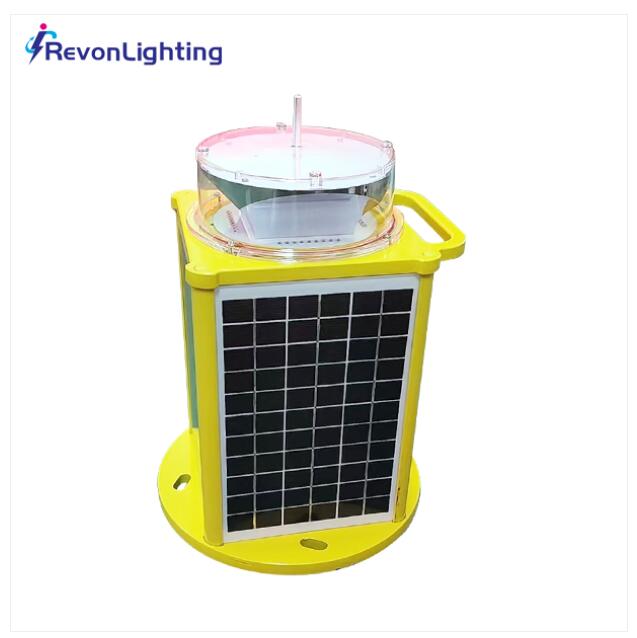In the ever-evolving field of aviation, safety remains the utmost priority. One of the critical components ensuring this safety is the use of specialized lighting systems that make obstacles visible to pilots, preventing collisions and guiding aircraft safely. Among these essential lighting solutions are the aviation warning light and the solar aviation light. This article delves into the significance, features, and benefits of these lighting systems, highlighting their crucial roles in enhancing aviation safety.
The Role of Aviation Warning Light
An aviation warning light is designed to mark tall structures and potential obstacles, making them visible to aircraft. These lights are essential for preventing accidents, especially during nighttime or in low-visibility conditions. The use of aviation warning lights ensures that pilots can identify and avoid obstacles, thereby enhancing overall flight safety.
Features of Aviation Warning Light
High Visibility: Aviation warning lights are typically high-intensity and can be seen from significant distances. They often use bright colors like red or white to stand out against the backdrop of the night sky or fog.
Flashing and Steady Modes: These lights can operate in steady or flashing modes. Flashing lights are particularly effective in attracting attention, making them ideal for marking critical obstacles.
Durability: Designed to withstand harsh weather conditions, aviation warning lights are robust and reliable. They can endure extreme temperatures, wind, rain, and snow, ensuring continuous operation.
Energy Efficiency: Modern aviation warning lights often use LED technology, which is energy-efficient and has a long lifespan. This reduces maintenance costs and ensures consistent performance.
Applications of Aviation Warning Light
Communication Towers: These lights mark communication towers, making them visible to aircraft and preventing collisions.
Wind Turbines: With the increasing number of wind farms, aviation warning lights are crucial for marking wind turbines, especially those located offshore.
Skyscrapers: Tall buildings and skyscrapers in urban areas are equipped with aviation warning lights to enhance their visibility to aircraft.
Industrial Structures: Chimneys, cranes, and other tall industrial structures use these lights to ensure they are easily recognizable from the air.
The Emergence of Solar Aviation Light
With the growing emphasis on sustainability and renewable energy, solar aviation lights have become a popular choice for marking aviation obstacles. These lights harness solar energy, providing an eco-friendly alternative to traditional aviation warning lights. Solar aviation lights are not only cost-effective but also reduce the environmental impact, making them an ideal solution for modern aviation safety.

Benefits of Solar Aviation Light
Energy Independence: Solar aviation lights operate independently of external power sources. They use solar panels to capture and store energy from the sun, ensuring continuous operation even in remote locations.
Cost-Effective: While the initial installation cost may be higher, solar aviation lights reduce long-term costs by eliminating the need for electricity and reducing maintenance.
Environmentally Friendly: By using renewable energy, solar aviation lights contribute to reducing carbon footprints and promoting sustainability.
Ease of Installation: These lights do not require complex wiring, making them easier and quicker to install. This is particularly beneficial for temporary or remote installations.
Features of Solar Aviation Light
Self-Sustaining: Equipped with solar panels and batteries, solar aviation lights store energy during the day to power the lights at night.
Automatic Operation: Many solar aviation lights have sensors that automatically switch the lights on at dusk and off at dawn, ensuring they operate only when needed.
Durability: Designed for outdoor use, these lights are built to withstand extreme weather conditions and provide reliable performance.
Low Maintenance: With fewer moving parts and no reliance on external power sources, solar aviation lights require minimal maintenance.
Applications of Solar Aviation Light
Remote Towers: Solar aviation lights are ideal for marking towers in remote areas where connecting to the power grid is impractical.
Temporary Structures: These lights are perfect for temporary structures, such as construction cranes or event installations, where installing permanent power sources is not feasible.
Offshore Wind Farms: In offshore wind farms, where accessing power sources can be challenging, solar aviation lights provide an effective solution.
Environmental Conservation Areas: In areas where environmental conservation is a priority, solar aviation lights offer a low-impact solution, minimizing disruption to the natural habitat.
Integration of Aviation Warning Light and Solar Aviation Light
Combining the strengths of aviation warning lights with the sustainability of solar aviation lights results in a robust and eco-friendly solution for marking aviation obstacles. By integrating these technologies, it is possible to achieve optimal visibility and reliability while promoting environmental sustainability.
| Aviation Warning Light | 810 |
| l864 | l856 |
Compliance with Regulatory Standards
Both aviation warning lights and solar aviation lights must comply with stringent regulatory standards to ensure their effectiveness. Organizations such as the International Civil Aviation Organization (ICAO) and the Federal Aviation Administration (FAA) provide guidelines on the installation, color, intensity, and operation of these lights. Adhering to these standards ensures that the lights provide the necessary visibility and contribute to overall aviation safety.
Technological Advancements
The field of aviation lighting continues to evolve with advancements in technology. Innovations such as smart lighting systems, which allow for remote monitoring and control, enhance the reliability and efficiency of aviation lights. These systems can adjust light intensity based on ambient conditions, ensuring optimal visibility at all times. Additionally, improvements in battery technology and solar panel efficiency are making solar aviation lights more effective and reliable.
Conclusion
Aviation warning lights and solar aviation lights are critical components in ensuring aviation safety. By making obstacles visible to pilots, these lighting systems help prevent collisions and guide aircraft safely. The integration of LED technology and solar power has enhanced the efficiency, durability, and sustainability of these lights. Adhering to regulatory standards and incorporating the latest technological advancements ensures that these lights provide the necessary visibility and reliability. As the aviation industry continues to grow, maintaining and improving these lighting systems will be essential for safeguarding the skies and promoting safe and sustainable air travel.